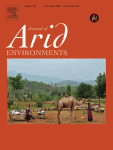Ver ítem
- xmlui.general.dspace_homeCentros Regionales y EEAsCentro Regional Patagonia NorteEEA BarilocheArtículos científicosxmlui.ArtifactBrowser.ItemViewer.trail
- Inicio
- Centros Regionales y EEAs
- Centro Regional Patagonia Norte
- EEA Bariloche
- Artículos científicos
- Ver ítem
Environmental influence on Merino sheep wool quality through the lens of seasonal variations in fibre diameter
Resumen
Wool production in arid and semiarid rangelands is strongly affected by environmental variability. Seasonal fluctuations of the environmental conditions drive variations in the nutritional status of the sheep, wool growth and quality. The variation of fibre diameter during the annual growth period can be observed through the Fibre Diameter Profiles (FDP). The FDP provide a retrospective description of animal responses to varying environmental and
[ver mas...]
Wool production in arid and semiarid rangelands is strongly affected by environmental variability. Seasonal fluctuations of the environmental conditions drive variations in the nutritional status of the sheep, wool growth and quality. The variation of fibre diameter during the annual growth period can be observed through the Fibre Diameter Profiles (FDP). The FDP provide a retrospective description of animal responses to varying environmental and management conditions during the wool growth period. Certain characteristics of FDP influence wool quality because this is associated with the performance during processing. The aim of this paper was to assess the variation of the FDP during the 2014–2015 wool growth period on farms located in a longitudinal environmental
gradient of Northern Patagonia, Argentina. Some features of the FDPs were found to be associated to the geographical location of the farms. For example, the minimal fibre diameter occurred at different times on the farms during the annual wool growth. The results of this paper support the relevance of the environment in generating seasonal variations in fibre diameter, which might be associated to animal stressful circumstances. However, future research is needed to better understand the influence of climatic conditions and other stressful circumstances for animals.
[Cerrar]

Fuente
Journal of Arid Environments 181 : Art. 104248 (October 2020)
Fecha
2020-10
Editorial
Elsevier
ISSN
0140-1963
Formato
pdf
Tipo de documento
artículo
Palabras Claves
Derechos de acceso
Restringido
 Excepto donde se diga explicitamente, este item se publica bajo la siguiente descripción: Creative Commons Attribution-NonCommercial-ShareAlike 2.5 Unported (CC BY-NC-SA 2.5)
Excepto donde se diga explicitamente, este item se publica bajo la siguiente descripción: Creative Commons Attribution-NonCommercial-ShareAlike 2.5 Unported (CC BY-NC-SA 2.5)

